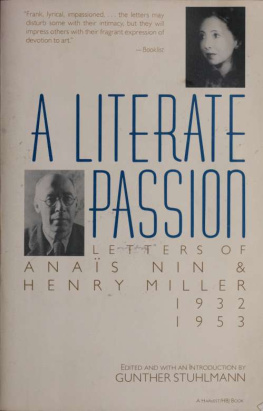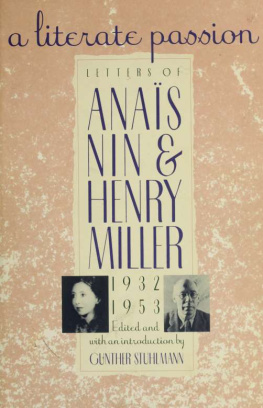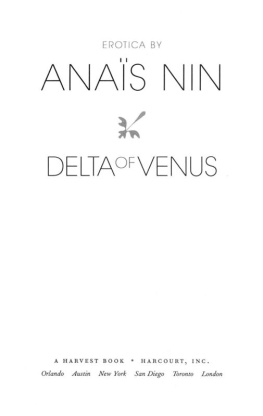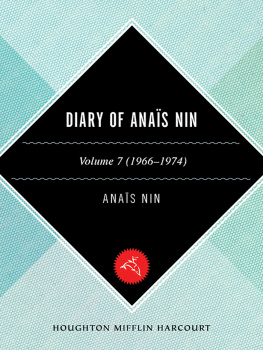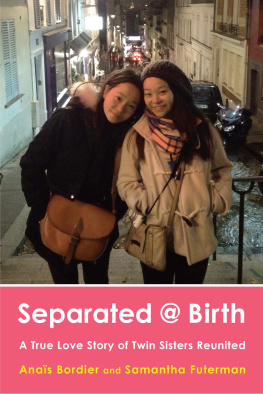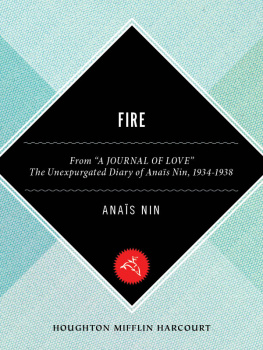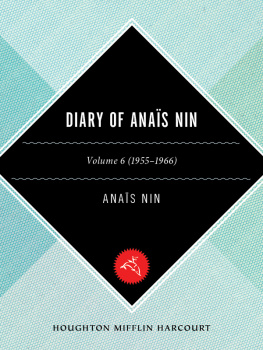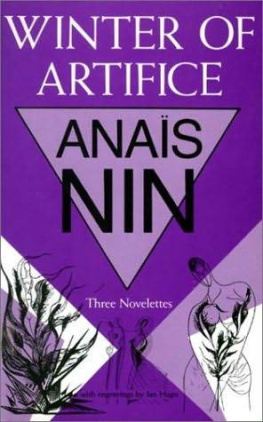Mirages
The Unexpurgated Diary
of
Anas Nin
1939-1947
Edited by Paul Herron
Introduced by Kim Krizan
First Kindle edition copyright
2013 Sky Blue Press
http://www.skybluepress.com
ALL RIGHTS RESERVED. This book contains material protected under International and Federal Copyright Laws and Treaties. Any unauthorized reprint or use of this material is prohibited. No part of this book may be reproduced or transmitted in any form or by any means, electronic or mechanical, including photocopying, scanning, PDF download, recording, blogging, internet posting, content syndication, e-mail or by any information sharing, storage and retrieval system without express writte n permission from the publisher, except by a reviewer or scholar who may quote brief passages in a review or article.
Inquiries about worldwide electronic rights and reproductions from all digital trade vendors should be directed to Sky Blue Press (skybluepress.com/.org).
Inquiries regarding worldwide print rights or reproductions, and from all scholarly and academic vendors regarding electronic rights, should be directed to Ohio University Press/Swallow Press (ohioswallow.com).
All content unless otherwise stated, copyright 2013 The Anas Nin Trust (anaisnintrust.com) ; Introduction copyright 2013 Kim Krizan; Preface copyright 2013 Paul Herron
Excerpts from The Diary of Anas Nin, Volume Three , 1939-1944 (copyright 1969 by Anas Nin and renewed by Rupert Pole and Gunther Stuhlmann) and The Diary of Anas Nin, Volume Four , 1944-1947 (copyright 1971 by Anas Nin and renewed by Rupert Pole and Gunther Stuhlmann) reprinted by permission of Houghton Mifflin Harcourt Publishing Company. All rights reserved.
Edited by: Paul Herron
Published by: Sky Blue Press, San Antonio, TX
Cover design: Beth Pratt, Ohio University Press/Swallow Press, and Sara A. Herron, Sky Blue Press
All photographs copyright The Anas Nin Trust, with the following exceptions: Edward Graeffe: James Abresch, photographer ; Valentina Orlikova: Soviet Russia Today (April 1943); Anas Nin in Provincetown: Jos Alemany, photographer; Anas Nin in action coat: Soichi Sunami, photographer.
This book is dedicated t o Gunther and Barbara Stuhlmann
Acknowle dgments
The editor gratefully acknowledges The Anas Nin Trust, Sara Herron, John Ferrone, and Kim Krizan for their guidance and dedication to this book.

Anas Nin at Provincetown
TABLE OF CONTENTS
n
PREFACE
Mirages is the untold story of Anas Nins personal struggle to keep alive what she valued most in lifethe dreamin the face of the harsh, puritanical climate of 1940s New York. It is a record of a journey across what Nin called the desert before me and witness to her painful rebirth as a woman and writer. It is the story missing from The Diary of Anas Nin , particularly volumes 3 and 4, which also cover 1939 through 1947.
This book finally answers what readers have been asking for decades: What led to the demise of Nins love affair with Henry Miller? Just how troubled was her marriage to Hugh Guiler? What is the story behind Nins children, the effeminate young men she seemed to collect at will? How was it that Nin wrote so prolifically during such a tumultuous time? What is the truth about her mysterious relationship with Gore Vidal? And what was it about Rupert Pole that seemed to assuag e all the pain Nin had endured?
In 1939, shortly after fleeing wartime Paris for New York, Nin wrote: Over and over again I sail towards joy, which is never in the room with me, but always near me, across the way, like those rooms full of gayety one sees from the street, or the gayety in the street one sees from a window. Will I ever reach joy? By 1946, her search had devolved into agony: The greatest suffering does not come from living in mirages, but from awakening . There is no greater pain than awakening from a dream, the deep crying over the dying selves
As World War II spread across the world, Nin waged her own war against a reality she found so horrifying that she repeatedly contemplated suicide and sought temporary salvation in numerous doomed love affairs with an assortment of men, ranging from the staid critic Edmund Wilson to seventeen-year-old Bill Pinckard, searching for the One who could respond to her, not only sensually, but completely . When none of her many lovers could live up to her ideal, she exclaimed to the diary: Oh, someone, someone love me as I have loved. It was only after abandoning her quixotic quest that Nin met Rupert Pole, the ardent lover who seemed to answer her needsand who would eventually prompt her to swing back and forth across the continent between him and her husband for the rest of her life.
Nin wrote in 1943, I feel like rewriting the entire diary in two columns: the actual diary as it is and its completion la Proustfilling, rounding, objectifying, encircling, encompassing all.
While Nin never actually put her diary into two columns, this aspiration was achieved, to an extent, in her publication history. She published the objectified version in the form of The Diary of Anas Nin , but with one major omission: because her husband and some of her lovers were still alive at the time, she was forced to excise an entire side of her characterthe eroticfrom the text. While Mirages could have been a simple accumulation of what was left out of the Diaries , the higher aim was to assemble the most meaningful material from the missing column and reconstruct Nins story, and what a story it is.
Here, the hazy, almost imagined images and the vague angst of the Diary snap into eye-searing focus, cast in a strong, sharp, defining light, laid bare for the reader. It is sometimes shocking, sometimes beautiful, sometimes agonizing, with little left to the imagination. The personages of the Diary become real people with real flaws and real problems; the transformation Nin undergoes is made brutally clear.
Mirages is a document of heartbreak, despair, desperation, carnage and deep mourning, but it is also one of courage, persistence, evolution and redemption.
Paul Herron, San Antonio, Texas, March 2013
[ ]
INTRODUCTION
Anas Nins diary is a remarkable work of art. Because she believed the topsoil of our personalities is nothing, her diary chronicles her interior life, the uncensored dream, the free unconscious, and it unspools like a tickertape. It is a deeply personal document, one that not only reveals the psychological topography of one woman, but one that unveils something of the interior life of all women, all people.
This new uncensored diary is particularly explosive. It will no doubt enflame the usual brigade of outraged moralists who have heaped scorn upon Nin for daring to live by her own moral code, write about her adventures, and then allow that writing to be published for all to read. The vitriol with which she has been attacked proves her diary hits a nerve, but as H. G. Wells said, Moral indignation is jealousy with a halo.
We know that in the great experiment that was her life, Anas Nin did things few of us would admitor even consider. Most of her secrets involved her sex life, an area women have fought to control on their own terms. Nin had what appears to have been an incredibly full and exciting life, but she believed she suffered from neurosis or sickness, and she fought to understand its cause. In the meantime, and without even a high school education, Nin forged a modern art form that will finally find its place in this century of internet communication, full, as it is, of personal confession. But Nin was decades and light-years ahead, trailblazing the exploration of an area of human life so mysterious, so elemental, so beyond politics and social mores, so personal, and yet so universal. To Nins detractors one must ask, If ones lens is too small to fit the mysteries of one complex life, if that life must be condemned, what in the critics own complex psyche do they condemn and attempt to destroy?
Next page

